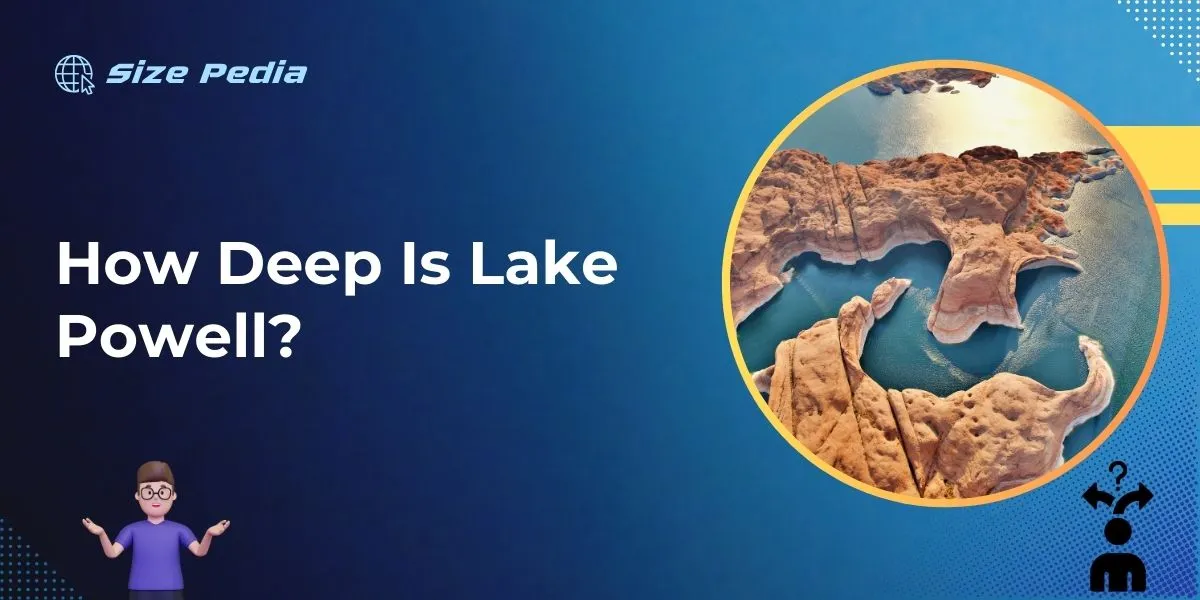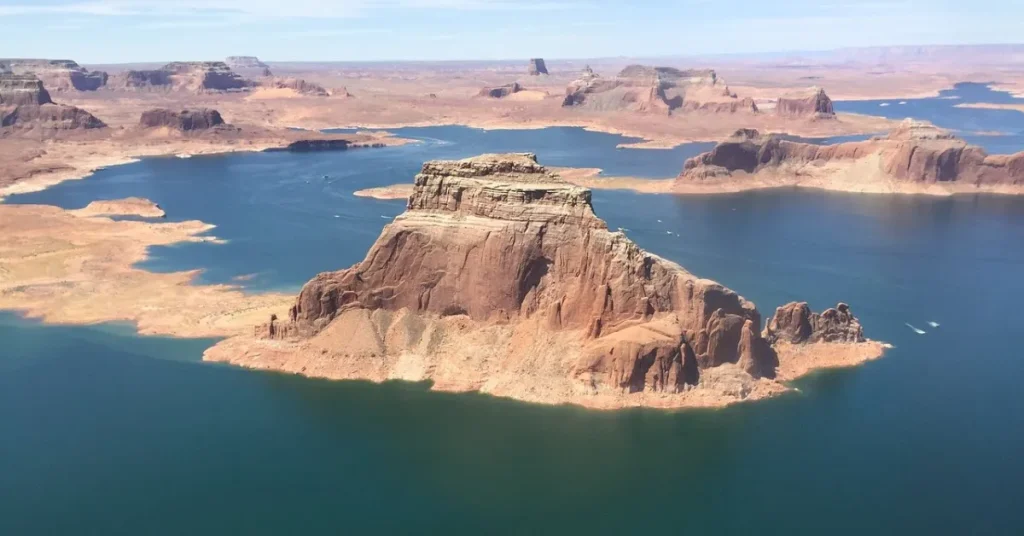Lake Powell has an average depth of approximately 130 feet. Its maximum depth can reach up to 583 feet when at full pool.
Nestled amidst the red rock desert scenery of the American Southwest, Lake Powell offers a stunning mix of serene waters and dramatic landscapes.
With over 2,000 miles of shoreline that twist and turn through canyons, this man-made reservoir has become a haven for boaters, anglers, and adventure seekers.
Lake Powell stands as the second-largest reservoir in the United States by maximum water capacity, but its levels can fluctuate significantly with the seasons and changing climate conditions.
This iconic lake, primarily located in Utah and extending into Arizona, not only serves as a prime recreational spot but also plays a critical role in water storage, flood control, and hydroelectric power generation for the region.

Lake Powell’s Vast Depths
Imagine exploring a watery labyrinth where the depths can plunge nearly as tall as a skyscraper.
Lake Powell, the jewel of the Colorado Plateau, boasts such profound depths. Its waters hold secrets and natural wonders below the surface, inviting the bold to discover its underwater terrain.
Measuring The Inaccessible
Pinpointing Lake Powell’s exact depth is a challenge. The lake’s remote sections often defy easy measurement. Yet, advanced technology allows us to peek into these hidden pockets.
Sonar devices cast sound waves down into the abyss, echoing back data that paints a picture of the underwater landscape. Precise measurements reveal depths that often exceed 500 feet, making Lake Powell an aquatic giant.
Beneath The Surface
Beneath the shimmering blue, there’s a world few have seen. Steep canyon walls slope into the darkness. Here, ancient water channels snake through submerged rock formations.
Divers and remotely operated vehicles (ROVs) explore this serene, isolated realm. They uncover cliff walls lined with mineral streaks and ledges that host aquatic life. This hidden world remains a frontier for discovery within Lake Powell’s vast depths.
| Area | Average Depth | Max Depth |
| Glen Canyon | 130 feet | 560 feet |
| Padre Bay | 100 feet | 450 feet |
| Rock Creek Bay | 90 feet | 380 feet |
- Sonar mapping provides depth insights.
- ROVs enable underwater exploration.
- Submerged canyons and rock formations create an aquatic maze.
Historical Water Levels Of Lake Powell

Lake Powell’s water levels have a story to tell. This tale is not just of a lake. It is a reflection of history: people, nature, and policy in concert and conflict. Understanding the historical water levels of Lake Powell reveals much about its past and gives hints to its future.
Chronicles Of Fluctuation
The lifeblood of Lake Powell has ebbed and flowed since its birth in 1963.
- Initial filling: It began filling after Glen Canyon Dam’s completion.
- Highs in the 1980s: The lake reached full capacity in 1980.
- Lows in the 2000s: Record lows were observed in the early 2000s.
This dance of depths, rising and falling, marks the pages in Lake Powell’s liquid ledger.
Impact Of Climate Change
Climate change has rewritten the rules of Lake Powell’s hydrology. Rising temperatures and unpredictable rainfall patterns are new actors in the drama of lake levels.
These forces interact with human demands to paint a complex water level picture.
| Year | Water Level (feet) | Notes |
| 2000 | 3,664 | Start of drought conditions |
| 2005 | 3,555 | Low level recorded |
| 2019 | 3,617 | Slight rebound |
The future of Lake Powell’s water levels hangs in a delicate balance, spurred by climate change.
Ecological Significance
The ecological significance of Lake Powell extends beyond its stunning vistas. Nestled within the Colorado Plateau, this man-made reservoir supports various ecosystems.
Its impressive depth creates a unique aquatic environment. Here we dive into the ecological layers of Lake Powell.
Habitats In The Deep
Lake Powell’s depths act as a nurturing ground for diverse habitats. These areas provide shelter and food for wildlife.
The depth ranges significantly, with some portions reaching over 500 feet. Below the surface, varying temperatures and light levels form distinct ecological zones.
- Shallow zones: home to algae and plant life
- Middle zones: habitat for small fish
- Deepest areas: refuge for larger species
Unique Species Of Lake Powell
In this reservoir, several unique species thrive. From fish to invertebrates, the biodiversity is rich.
| Fish Species | Adaptations |
| Carp | Bottom feeders, adapt to low light |
| Bass | Ambush predators, use depth to hide |
| Bluegill | Vivid colors, inhabit clearer waters |
Protecting these species ensures Lake Powell remains an ecological treasure.
The Human Element
Lake Powell is not just a body of water—it is a canvas for human interaction. People come to its shores seeking solitude and adrenaline, tranquility and excitement.
The human touch shapes and redefines this magnificent landscape daily, crafting memories and experiences unique to each visitor. While Lake Powell offers endless recreation, the human element brings its own challenges to conservation efforts.
Recreational Haven
The vast blue expanse of Lake Powell beckons a wide array of activities for all ages.
- Boating
- Swimming
- Hiking nearby trails
- Fishing for diverse species
This breathtaking reservoir serves as a perfect backdrop for both relaxation and adventure. Kids and adults alike find joy and freedom in the splash of the waves and the warmth of the sun-drenched canyons.
Challenges In Conservation
While Lake Powell enchants visitors, it faces conservation challenges. The impact of recreational activities needs active management.
| Concern | Impact | Action |
| Water levels | Fluctuate with usage | Mitigate through educated use |
| Erosion | Alters shores | Enforce no-wake zones |
| Pollution | Affects wildlife | Implement cleanup initiatives |
Active involvement from visitors and locals alike ensures that Lake Powell remains pristine for generations to come.
Appreciating the wonders of nature comes with the responsibility of preserving it. The balance between enjoyment and protection defines the sustainability of this treasured natural resource.
Technological Advances In Depth Mapping
Exploring the depths of Lake Powell has reached new heights with cutting-edge technologies. These digital tools create accurate maps of underwater landscapes. Let’s dive into how these technologies reveal the mysteries of Lake Powell’s depths.
Innovations In Sonar Technology
Depth discovery at Lake Powell has transformed with advanced sonar equipment. This sonar pulses sound waves underwater, reflecting off the lake bed to detect depth changes.
- Multi-beam sonar systems cover a wide area, producing detailed depth data.
- Side-scan sonar offers high-resolution images, exposing underwater features like never before.
These systems navigate previously hard-to-map areas. They bring to life a world beneath the surface with remarkable accuracy.
Data Visualization And Lake Topography
Data visualization turns depth data into understandable maps. These maps show Lake Powell’s underwater topography.
- Software combines sonar readings to generate 3D visualizations of the lake bed.
- GIS technology layers the information, providing insights into Lake Powell’s structure.
With these tools, scientists and explorers can visualize the lake in ways that were once impossible.
| Tool | Function |
| Multibeam Sonar | Detailed depth measurement |
| Side-scan Sonar | High-res bottom imagery |
| GIS Software | 3D mapping and analysis |
Preserving A Natural Wonder

Lake Powell, a reservoir on the Colorado River, is not just a body of water. It’s a gleaming gem nestled amidst rocky terrain. Its depth has intrigued many, reaching depths of over 500 feet when full. Keeping this natural wonder intact is vital for the environment and future generations.
Policy And Protection
Environmental policies play a crucial role in safeguarding Lake Powell. Organizations work tirelessly to maintain its pristine conditions. They focus on controlling pollution and managing the surrounding ecosystem.
Stricter regulations on fishing, boating, and water use help preserve Lake Powell’s beauty and resources.
- Water Quality Standards: Aim to keep the lake clean and healthy.
- Habitat Conservation: Protects wildlife in and around the lake.
- Recreational Management: Ensures sustainable tourism activities.
Future Projections Of Water Levels
Climate change and extended droughts pose significant threats to Lake Powell’s water levels. Scientists use advanced models to predict future water availability.
These models help in making critical decisions for water conservation and usage.
| Year | Projected Water Level (feet) |
| 2025 | 3,560 |
| 2030 | 3,550 |
| 2035 | 3,540 |
Estimations are subject to change based on weather patterns and conservation efforts.
FAQs About How Deep Is Lake Powell
What Is The Maximum Depth Of Lake Powell?
Lake Powell’s maximum depth reaches approximately 558 feet (170 meters) at its deepest point. This depth can fluctuate with seasonal water levels and drought conditions.
How Does Lake Powell’s Depth Compare To Other Lakes?
Compared to other lakes, Lake Powell ranks high for depth. While not as deep as Lake Tahoe or Crater Lake, it surpasses many other well-known lakes in depth, offering unique boating and exploration opportunities.
What Area Does The Deepest Part Of Lake Powell Cover?
The deepest part of Lake Powell is found at the Glen Canyon Dam. This section, near the dam, holds the greatest volume of water and thus has the greatest depth.
How Has Lake Powell’s Depth Changed Over Time?
Lake Powell’s depth has historically fluctuated due to varying precipitation levels and water usage. Drought conditions in recent years have led to noticeable decreases in its maximum depth.
Conclusion
Exploring the depths of Lake Powell reveals a marvel of both natural beauty and human engineering. At points reaching depths of over 500 feet, it serves as a stunning retreat for nature lovers and adventurers alike.
Remember, its vast waters and intricate canyons offer more than a simple measurement can convey, inviting visitors to delve into its many wonders firsthand.
Safe travels as you discover the profound splendor of Lake Powell’s aquatic depths.
Resources:
1. https://www.usgs.gov/centers/southwest-biological-science-center/science/lake-powell-research
